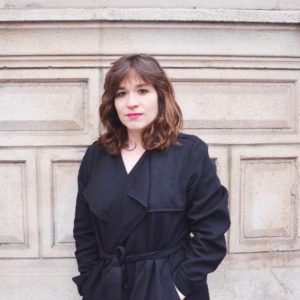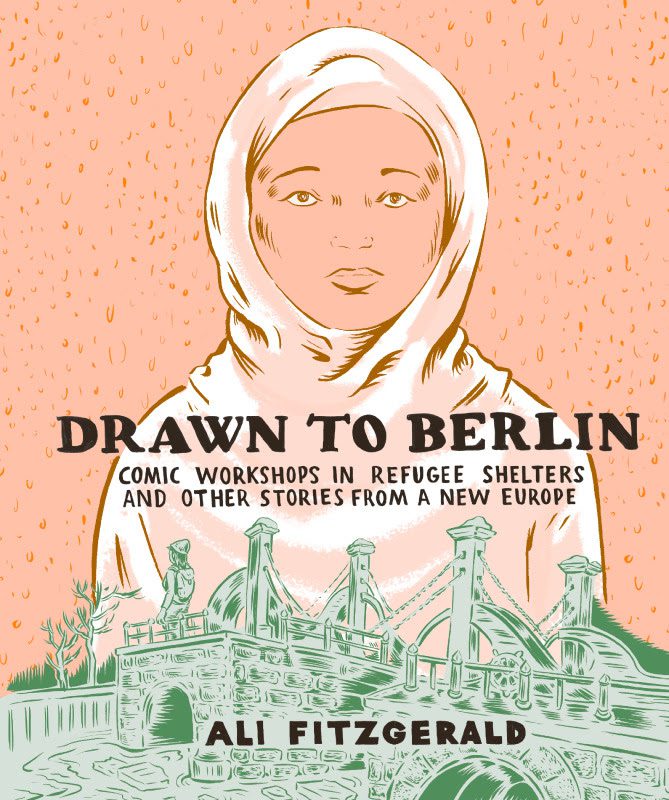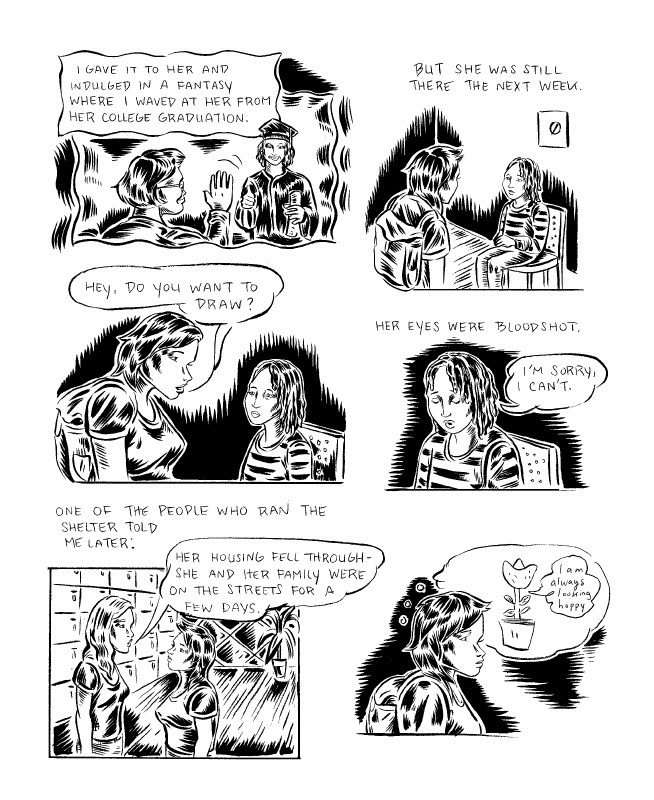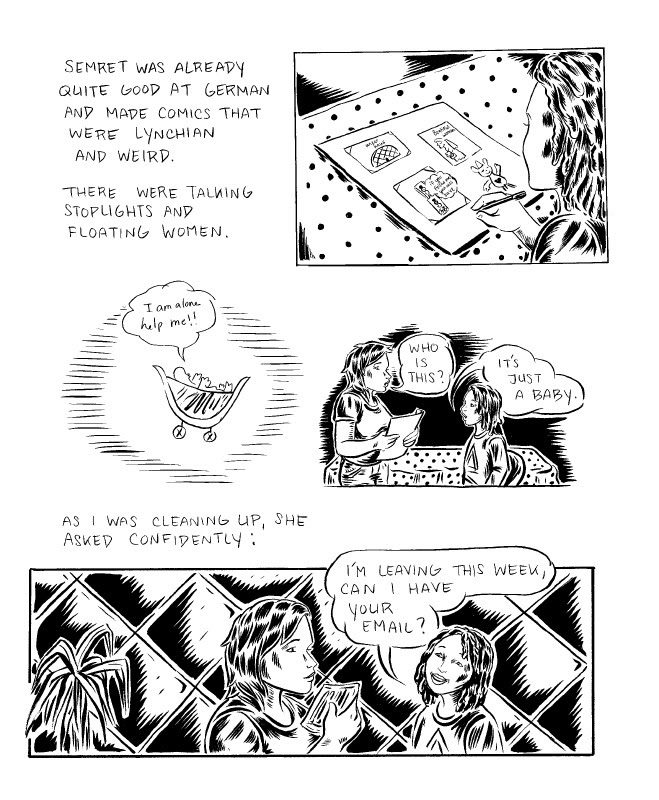
The comic artist and writer Ali Fitzgerald regularly contributes to publications including the New Yorker, New York Magazine’s The Cut, the New York Times, and Bitch. Her popular web-comic Hungover Bear and Friends has also been featured in McSweeney’s, she wrote the column Queer Berlin for Art21, and in conjunction with a 2018 exhibition the San Francisco Museum of Modern Art enlisted her to create an imaginative series of graphic works depicting backstories for René Magritte’s most iconic characters.
For the last eight years, Fitzgerald has lived and worked in Berlin. In addition to leading visual storytelling workshops at the National Library of Germany and elsewhere, she has taught her craft to asylum seekers—an experience that inspired her to write the new graphic memoir Drawn to Berlin: Comic Workshops in Refugee Shelters and Other Stories from a New Europe. It’s quite an extraordinary book—a thoughtful and deeply empathetic examination of displacement and hope, focusing on the situation of immigrants in Berlin, past and present. More broadly, it’s also a book about memory and the power of sharing stories.
***
The Rumpus: Before working in comics, you were trained in other forms of visual art. When did you make the transition?
Ali Fitzgerald: I would say I went back and forth. When I was a kid, maybe up to age twenty, I did comics regularly. I made them, read them, consumed them, and created them. Then I went to grad school at the University of Texas, which was great, but I got more invested in installation and painting. In the mid-2000s, comics and other graphic arts weren’t viewed as being particularly relevant to contemporary art and dialogue, so I stopped doing comics and focused instead on paintings and drawings, etc. I was still telling stories, but they were just a bit more fragmented.
Rumpus: What brought you back to comics?
Fitzgerald: When I moved to Berlin, I became kind of melancholy. I wasn’t making work that I felt super good about. I felt really lost and comics were a way for me to go back to something I really loved. Also, you know, I was really broke at the time. In a way comics are a very humble medium. You just need paper and a pencil or pen—or a brush. I did comics in my room in Berlin and retaught myself how to make the kind of work I wanted to make. The process was bumpy at first, and I made comics that I will never show to anyone. I actually have a folder on my old computer that’s named “sad comics.” But after a few years, and concurrently making drawings and showing them places, I started to patch together my own vernacular and make my own stories. At some point the threads connected.
Rumpus: To go back for a moment, what initially brought you to Berlin?
Fitzgerald: I think part of it was this mythos that a lot of people talk about. When I was about thirteen I read Christopher Isherwood’s The Berlin Stories and I just really liked this idea of Berlin as a space for queer freedom, and political freedom, and as a place for people who might be othered in other spaces as well. I first came here during a winter when I’d been teaching at UT, and I liked it, so I came back and decided to stay.
Rumpus: Were you fluent in German before you moved to Berlin?
Fitzgerald: No! Not at all! For anyone who wants to move to Berlin, the one piece of advice I have is to take a language course before you go. It makes life a lot easier. In a day-to-day way you can get by without being fluent because Berlin is very cosmopolitan—and you need German even less now compared to when I moved here—but there is still a fundamental part of the city that you miss out on when you don’t speak German. It took me quite a few years to learn it. When I got here, I thought I could teach myself, but in retrospect that was just arrogant.
Rumpus: How did you become connected with the refugee community, and did you need to overcome language barriers to work with these new arrivals to Germany?
Fitzgerald: I started out teaching comics to people who identified as women, and then the director of a refugee shelter approached me and asked if I would be willing to conduct a workshop with teenage boys. I enthusiastically said yes because for a long time I’d been thinking about comics as an outlet for different types of expression. The first place I gave workshops was an emergency shelter—people were just arriving so communicating in English was a little bit easier. But as more refugees came, and the asylum process started slowing down, we started communicating more in German, which people really wanted to learn. Some classes were half in English and half in German. Sometimes I would ask people in the class to help by becoming impromptu translators. Other times there were no common languages, which made us get really creative with drawing. It was a beautiful part of our classes actually.
Rumpus: Was there a particular moment when you explicitly started thinking about their comics as memoirs?
Fitzgerald: I became interested in how their drawings, and my drawings, expressed nuances of personhood. At first I thought about doing some kind of recurring comic that would allow readers to identify with characters in a real-time way. Then I started taking notes on the classes, and documenting my experiences working with them, and eventually—maybe after about a year—I started to think about writing a book.
Rumpus: It’s a very complicated prospect, telling someone else’s story, and you take great care to approach it ethically. As their stories unfold in the book, we also gain insight about your thoughts and feelings as a storyteller. At one point you reflect on what that means—your hopes and concerns about representing the students and their experiences. You said it was sometimes hard not to project onto other people’s drawings, but did that become easier to negotiate as you built relationships?
Fitzgerald: I don’t think it necessarily got easier. For me, that only grew more complicated as I worked on the book. My investment deepened, as did the responsibility for telling their stories. At the same time, media narratives were so flattening I wanted to show these smaller moments, to show that people who are fleeing war are different, have dignity, and at the same time can talk about stuff like The Walking Dead, they are pharmacists, or farmers, etc.—in other words, that they’re not a homogenous group.
Rumpus: Tell me more about that juxtaposition.
Fitzgerald: Media portrayals tend to focus on numbers and crisis rhetoric. You have hero and victim tropes, or in the right wing press you see demonization where refugees are often characterized as evil religious zealots or criminals. These stereotypes are pernicious and harmful. In the book what I tried to do is document what I saw, and what I saw was complex, and nuanced, and incredibly moving, and often depressing.
Rumpus: In terms of process, one of the inspirations you cite is the Austrian journalist Joseph Roth and his documentation, roughly a hundred years ago, of the experiences of Eastern European Jewish refugees seeking asylum in the aftermath of World War I and the Russian Revolution. Were there other writers you looked to, say from the world of comics?
Fitzgerald: Roth empathetically documented people who were displaced in a lot of different ways, for example Berlin’s homeless population, and also sex workers in Berlin. I looked to Isherwood, too, and in comics to people like Joe Sacco. But I think representation is a thorny issue, perhaps especially in comics which are rooted in caricature. Also, comic journalism is still somewhat new, and the rules are still being established. I wanted to maintain my subjects’ anonymity, but not flatten their stories, so, for example, I had to decide whether or not to change their names. I also had to decide how much of myself to include explicitly, and how to include it.
Rumpus: Is that why you’ve referred to your work as “surreal nonfiction“? Because it attempts to document on multiple levels, including the semi-autobiographical and the subjective?
Fitzgerald: With journalism generally, there is still some idea that you can come at documentation from some completely objective outside standpoint. But I think on some level we all know that’s not true. You come to any story from a specific place. I tried to acknowledge that by being really clear in the book that I was coming at the experience from my perspective, my thoughts, and my feelings. There are some “surreal” passages that indicate that I’m not a detached authority. Everything is filtered though my vision.
Rumpus: This ties back to Isherwood—the quote taken from the first page of The Berlin Stories: “I am a camera with its shutter open, quite passive, recording, not thinking.“ But you’re acknowledging, as he did, that what is recorded is also bound to be “developed, carefully printed, fixed.”
Fitzgerald: Right! At one point “I Am a Camera” was actually my working title for the book.
Rumpus: Can we talk for a moment about your ideas about bohemia before you came to Germany, which were informed by Isherwood and others, and how they became complicated by your experiences on the ground?
Fitzgerald: Yes—another provisional title I had for the book was Two Berlins—referring to this mirage of bohemia and also two different waves of migration, privileged immigrants who document their lives through art, which Berlin has a lot of these days, and this other wave of people who are fleeing war and searching for greater economic stability and state stability.
Rumpus: I also see at least two more Berlins in your book, including the complicated Berlins of past and present. For example, a former school for Jewish girls who were sent to the death camps along with their teachers in 1942 was reopened in 2012 as a collection of art spaces and kosher restaurants.
Fitzgerald: The Jewish girls’ school, and the whole area around it, was the subject of a lot of discussion in the 70s. The decision was made not to memorialize it in any overt way and it’s possible a lot of people don’t even know about this history. With other examples in the book, such as Tempelhof, the deserted airfield, which was built by the Nazis as a symbol of Hitler’s “Germania,” has been preserved. At some point they considered turning it into some kind of celebrity spa/retreat, but Berlin ran out of money so they kind of left it. It became a free park, and in 2015 the hangars became the world’s largest refugee shelter. I think it could be argued that they were trying to negotiate history, trying to repurpose it towards a social good. That’s what it represents for a lot of people now. There are now community gardens where the warplanes once took off.
Rumpus: You also talk about going to a sex club that takes its name from the Kit Kat Club, which was fictional name for a real club called Heaven and Hell, that was frequented by Isherwood. In his account, this was center of bohemian nightlife set against the rise of the Nazis. In your book, the hopeful possibility of multi-ethnic democracy is set against the hardening of German tribalism. At the end of your book, it isn’t clear which will prevail.
Fitzgerald: Yes, in the space of just a few years, I saw a shift. At the end of the book, I ask if a country can overcome its history of barbarism to arrive at something new. I think Germany is at this intersection, facing a chance to create a more diverse society. In 2015 close to a million people came to Germany, and yet the rhetoric remains that immigrants increase crime and steal jobs. These are the same sickening headlines Roth wrote about in the 1920s. I don’t know how you can ignore the parallels. The dehumanization is so similar.
Rumpus: Given these historical parallels, is it possible for Berlin to live with its past without erasing or repeating it?
Fitzgerald: I want to be hopeful about the future. In some ways, Germany has taken on a lot of moral responsibility, especially in the beginning of what was deemed the refugee crisis. I saw a lot of people volunteering, trying hard to accept and help others, and it was really inspiring. But as migration has become more protracted, there has been an empathic lapse. Some story takes hold in people’s imaginations, for example that a particular immigrant killed someone, or a small group harassed and touched some women, and then we forget that crime has not increased overall or that migrants are actually a boon for the economy.
Rumpus: Do you see it getting worse?
Fitzgerald: There has been recent violence, for example the burning of a shelter that was supposed to house three hundred migrants and there was also a quite famous video where arriving refugees are taunted in a region called Saxony, where a political party called the AfD has taken hold. In a sense I feel less hopeful now. Ethnic nationalism is alive and well here and that is very scary.
Rumpus: What do you most want to convey about the experience of refugees in Germany?
Fitzgerald: For me, the most important thing is that we acknowledge that people contain multitudes.
Rumpus: At the very end of the book, you reference Roth’s observation that no one asks the wanderer where he’s going, only ever where he’s come from. Yet the stories you’ve shared consciously invite the wanderer to respond to both questions. How specifically can art bring us closer to understanding the situation of the refugee?
Fitzgerald: The workshops were meditative moments in the midst of a lot of chaos and the art the refugees made reflected their resiliency, and how much dignity they had in the face of experiences I can’t imagine. It allowed them to communicate and to be seen, and the experience of working with them showed me how art is important, and in some sense, even transcendent.
***
Photograph of Ali Fitzgerald by Nadja Sayej.







